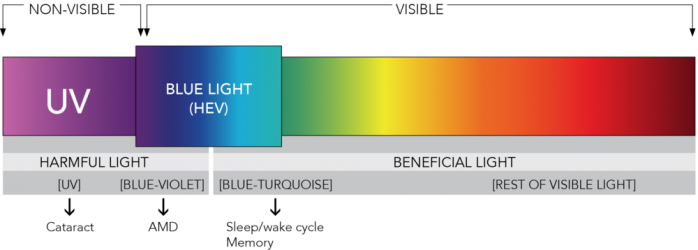BLUE LIGHT PROTECTION
Blue light is a part of the light that is found in the visible light spectrum that can be seen by the human eye. It is present in natural sunlight, and it is also emitted by electronic devices such as computers, smartphones, tablets, and LED lighting.
While blue light is not inherently harmful, excessive exposure to it can have negative effects on the body. Blue light has been shown to affect the body’s natural sleep-wake cycle, or circadian rhythm, which can lead to difficulty falling asleep and poor sleep quality. In addition, blue light has been linked to digital eye strain, which may cause symptoms such as dry eyes, headaches, and fatigue.

TYPES OF BLUE BLOCK LENSES
It’s important to know that not all blue light protection lenses are created equal, and the level of blue light protection they provide can vary widely. Generally, blue light protection lenses can be categorized under two distinct categories:
- Lens Material: These lenses are made from materials with built-in blue light absorbing properties.
- Applied Coating: These lenses filter blue light through the special coatings applied to them.
LENS MATERIAL | APPLIED COATINGS | |
| Technology | Absorbed by Material | Filtered by Coating |
| Blue Light Protection | Blocked | Selectively Filtered |
| UV Protection | Up to UV420 | Up to UV400 |
| Lens Tint | Slight Grey | Slight Yellow |
| Coating Hue | Usually Green | Blue-Purple |
| Pen Light Demonstration | Works | Does Not Work |
| Products | Lens Shapers: BlueShield UV Essilor: Blue UV Capture Nikon: Pure Blue UV | Lens Shapers: BlueFilter EC AR Essilor: Crizal Prevencia Nikon: SeeCoat Next Blue |
FAQs
What is blue light and where does it come from?
Blue light is a type of high-energy visible (HEV) light that is emitted by electronic devices such as computers, smartphones, and televisions, as well as by natural sources like the sun.
What are the potential negative effects of blue light exposure?
Blue light exposure has been linked to a number of potential negative effects, including eye strain, headaches, disrupted sleep patterns, and increased risk of macular degeneration.
How do blue light protection lenses work?
Blue light protection lenses are designed to block or filter out a portion of the blue light spectrum. This can help to reduce the amount of blue light that reaches your eyes and potentially mitigate some of the negative effects associated with blue light exposure.
Are blue light protection lenses only for people who work on computers all day?
No, blue light exposure is not limited to people who work on computers all day. Anyone who spends significant amounts of time using electronic devices or is exposed to natural sources of blue light could benefit from blue light protection lenses.
Do all blue light protection lenses look yellow?
No, not all blue light protection lenses have a yellow tint. There are clear blue light protection lenses available as well as lenses that have a subtle or barely noticeable tint.
Do blue light protection lenses block all blue light?
No, blue light protection lenses are designed to block or filter out a portion of the blue light spectrum, but they do not block all blue light. Some blue light is necessary for our health and well-being, so it is important to find a balance between blue light exposure and protection.
Do blue light protection lenses improve sleep?
Blue light exposure at night can disrupt our circadian rhythm and make it harder to fall asleep. While blue light protection lenses can help to reduce blue light exposure, it is important to also practice good sleep hygiene habits such as avoiding electronics before bed and keeping a consistent sleep schedule.
Are blue light protection lenses recommended for children?
Children may be especially vulnerable to the potential negative effects of blue light exposure because their eyes are still developing. With today’s lifestyle, kids are spending more and more time in front of digital devices making blue light protection lenses an excellent option for that age group.
Does the blue light pen demonstration work on all types of blue-light protective lenses?
The blue light pen demonstration, which involves shining a blue light pen through a blue light blocking lens to see if the lens is effective, may not work on all types of blue light blocking lenses.
Generally, lenses that protect against blue light by selectively filtering through their special coatings, cannot be tested using a blue light pen. Lenses that block blue light through their built-in material properties, such as Lens Shapers BlueShield, may lighten or completely block the blue light emitted from a blue light pen.
While the blue light pen demonstration can be a useful tool for testing some types of blue light blocking lenses, it may not be effective for all types of lenses.
